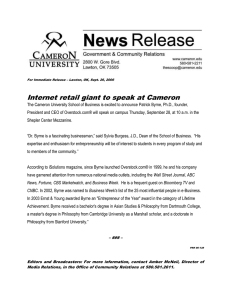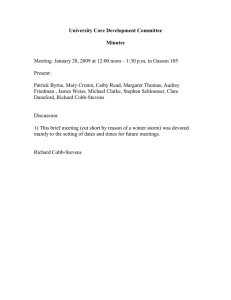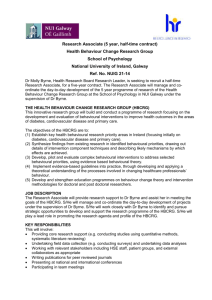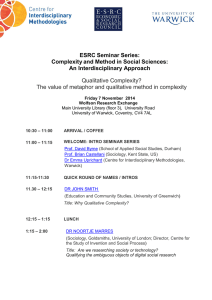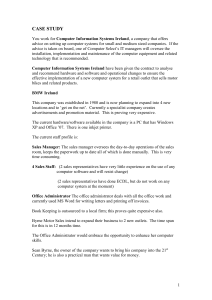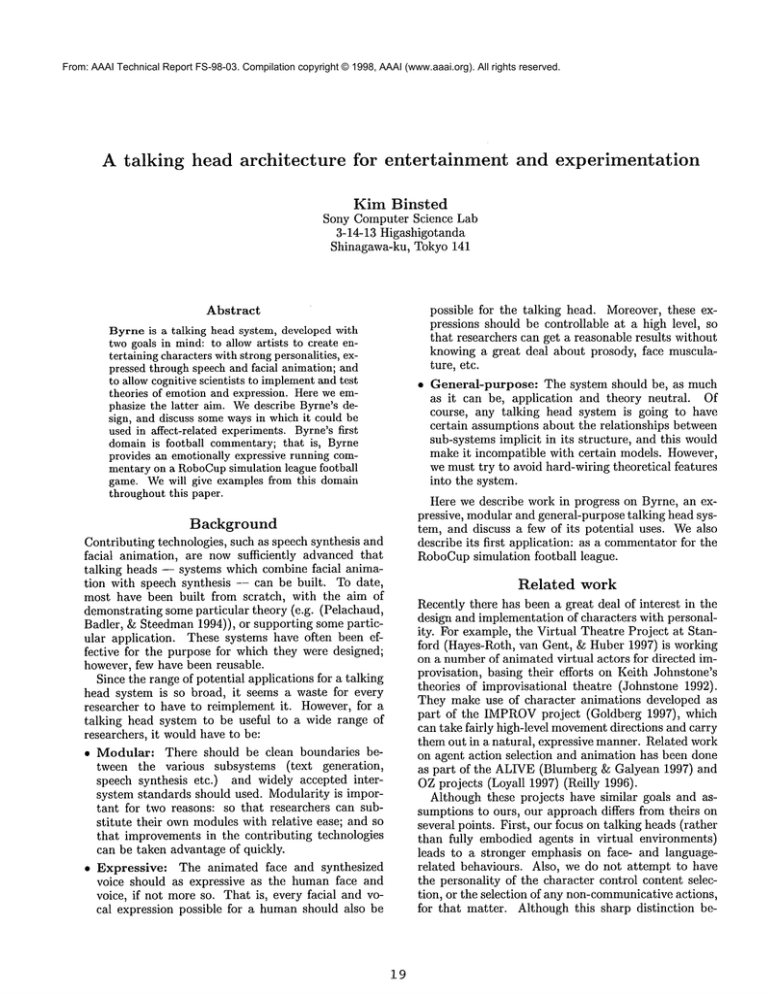
From: AAAI Technical Report FS-98-03. Compilation copyright © 1998, AAAI (www.aaai.org). All rights reserved.
A talking
head architecture
for entertainment
and experimentation
Kim Binsted
Sony Computer Science Lab
3-14-13 Higashigotanda
Shinagawa-ku, Tokyo 141
possible for the talking head. Moreover, these expressions should be controllable at a high level, so
that researchers can get a reasonable results without
knowing a great deal about prosody, face musculature, etc.
¯ General-purpose:
The system should be, as much
as it can be, application and theory neutral. Of
course, any talking head system is going to have
certain assumptions about the relationships between
sub-systems implicit in its structure, and this would
make it incompatible with certain models. However,
we must try to avoid hard-wiring theoretical features
into the system.
Abstract
Byrne is a talking head system, developed with
two goals in mind: to allow artists to create entertaining characters with strong personalities, expressed through speech and facial animation; and
to allow cognitive scientists to implementand test
theories of emotion and expression. Here we emphasize the latter aim. Wedescribe Byrne’s design, and discuss someways in which it could be
used in affect-related experiments. Byrne’s first
domain is football commentary;that is, Byrne
provides an emotionally expressive running commentary on a RoboCupsimulation league football
game. Wewill give examples from this domain
throughout this paper.
Here we describe work in progress on Byrne, an expressive, modular and general-purpose talking head system, and discuss a few of its potential uses. Wealso
describe its first application: as a commentatorfor the
RoboCupsimulation football league.
Background
Contributing technologies, such as speech synthesis and
facial animation, are now sufficiently advanced that
talking heads -- systems which combine facial animation with speech synthesis -- can be built. To date,
most have been built from scratch, with the aim of
demonstrating some particular theory (e.g. (Pelachaud,
Badler, & Steedman 1994)), or supporting some particular application. These systems have often been effective for the purpose for which they were designed;
however, few have been reusable.
Since the range of potential applications for a talking
head system is so broad, it seems a waste for every
researcher to have to reimplement it. However, for a
talking head system to be useful to a wide range of
researchers, it would have to be:
¯ Modular: There should be clean boundaries between the various subsystems (text generation,
speech synthesis etc.) and widely accepted intersystem standards should used. Modularity is important for two reasons: so that researchers can substitute their ownmodules with relative ease; and so
that improvements in the contributing technologies
can be taken advantage of quickly.
¯ Expressive: The animated face and synthesized
voice should as expressive as the human face and
voice, if not more so. That is, every facial and vocal expression possible for a humanshould also be
Related
work
Recently there has been a great deal of interest in the
design and implementation of characters with personality. For example, the Virtual Theatre Project at Stanford (Hayes-Roth, van Gent, & Huber 1997) is working
on a numberof animated virtual actors for directed improvisation, basing their efforts on Keith Johnstone’s
theories of improvisational theatre (Johnstone 1992).
They make use of character animations developed as
part of the IMPROVproject (Goldberg 1997), which
can take fairly high-level movementdirections and carry
them out in a natural, expressive manner. Related work
on agent action selection and animation has been done
as part of the ALIVE(Blumberg & Galyean 1997) and
OZprojects (Loyall 1997) (Reilly 1996).
Although these projects have similar goals and assumptions to ours, our approach differs from theirs on
several points. First, our focus on talking heads (rather
than fully embodied agents in virtual emdronments)
leads to a stronger emphasis on face- and langnagerelated behaviours. Also, we do not attempt to have
the personality of the character control content selection, or the selection of any non-communicativeactions,
for that matter. Although this sharp distinction be-
19
I
Text
face animation
speechsynthesis
I
Wehave made heavy use of inter-system standards,
especially SGML-based(Goldfarb 1991) mark-up systems, in an attempt to make Byrne as modular as possible. This is both so that researchers working on related technologies can make use of Byrne to demonstrate their systems with a minimumof fuss, and so
that Byrne can be improved as its supporting technologies advance.
The ’SEEML’mark-up language referred to in Figure 1 is, at present, little more a concatenation of
three other SGML-based mark-up languages:
GDA
(Global Document Annotation)
(Nagao & Hasida
1998), which indicates the linguistic structure of the
text; Sable (Sable 1998), which adds information relevant to speech synthesis (rate, prosody etc.); and FACSML, which is a FACS-based (Ekman & Friesen 1978)
mark-up for control of facial expressions. These have
been supplemented with a shorthand for some of the
more commoncombinations of tags. Here is an example of SEEMLtext:
I
BYRNE
I faC| S~’ecljOn
I ~1
<CHARACTER ID = "Tammy"> <FROWN> I
am so tired of this. <SHOUT>
Whydont you ever
<EMPH> listen
</EMPH> to me! </SHOUT>
<WHISPER>I tell you, <BREAK>I could just
<EMPH> scream
</EMPH>. </WHISPER>
<AUDIO SRC="scream.au">
</LANGUAGE>
<LANGUAGE
ID=" FRENCH" >
<GRIMACE>Ah, mince alors!
</GRIMACE>
</LANGUAGE> </CHARACTER>
; e nm°e~°:°
n
gameanalysis
mark-up
simulator
Figure 1: The Byrne system architecture
Input
Although the talking head can work directly from
SEEMLtext, here we are more interested
in having
Byrne react emotionally to events in some domain. The
system takes as input an ordered list of ’observations’
about the domain. In the soccer commentarycase, this
list is the output of a domainanalysis system, and contains observations about the state of play, the positions
of the players, the scores, etc. The analysis system must
maintain this list, reordering the observations as their
importance changes, and removing them when they become irrelevant or untrue. Here is an example of such
a list:
tween content and expression might negatively affect
the consistency of the character, a clear separation between content and expression allows the character to be
portable across content generators. For example, you
could have essentially the same character (an aggressive older Scottish man, for example) commentate your
soccer games and read your maps. In the first case, the
content-generating application is the RoboCupsoccer
simulator, and in the second case it is an in-car navigation system -- but the character remains the same.
There are two other research groups looking at the
automatic generation of commentary for RoboCup, one
in Japan(Tanaka-Ishii et al. 1997) and one in Germany(Andre, Herzog, & Rist 1998). Their emphasis,
however, is more on game analysis and text generation
than on expression.
¯ (goal player: a2 forteam: a fromloc: (20 10) begintime: 130 endtime: 135 importance: 10)
¯ (pass from: al to: a2 fromloc: (30 10) toloc: (20
begintime: 120 endtime: 125 importance: 8)
¯ (has-ball player: a2 location: (20 10) time: 125
portance: 5)
¯ (move player: bl fromloc: (5 10) toloc: (10 10)
gintime: 115 endtime: 120 importance: 3)
Byrne
See Figure 1 for an outline of the Byrne architecture.
The modules are described below. In the current implementation, none of the modules are very sophisticated;
however, we expect that they are independent enough
to be improved or replaced without large adjustments
to the rest of the system.
The automatic analysis of the RoboCupsimulation
league is an interesting research area in and of itself,
2O
and the generation and maintenance of such a list of observations is not a trivial task. However,football analysis is not our main goal here. Wehave implemented
a simple analyser which produces fairly low-level observations about the game(kicks, passes, goals and so on),
but we do not consider this to be a part of the Byrne
system.
(event type: goal benefits: TeamAbegintime: 130
endtime: 135 cause: (action type: kick actor: a2))
Of course, we could have simply written the analysis
system to generate observations in this form. However,
we cannot assume that we will always have access to
the internals of the various domain analysis systems.
The domain abstraction module serves as an interface
between the domain analyser and Byrne.
Text generation
Character has a role to play in natural language generation. For example, a character from a particular
country or region might use the dialect of that area,
or a child character might use simpler vocabulary and
grammarthan an adult. The current emotional state of
the character wouldalso have an effect: an excited, angry character might use stronger language and shorter
sentences than a calm happy one, for example. Loyall’s
work in the OZ project (Loyall 1997) discusses some
these issues.
Text generation is an area in which Byrne could be
very sophisticated, but is not. At present, text generation is done very simply through a set of templates.
Each template has a set of preconditions which con=
strain the gamesituations they can be used to describe.
If more than one template matches the chosen content,
then the selection is based on how often and how recently the templates have been used. Pointers to the
observations which caused the text to be generated are
maintained, to aid later text mark-up.
Byrne’s text generation module does not generate
plain text, but rather text marked up with SEEML.Although the speech synthesis system we use can generate
reasonable speech from plain text, it is helpful to retain
some phrase structure and part of speech (POS) information from the natural language generation process to
help the speech synthesis system generate appropriate
prosody.
Moreover, linguistic
information embedded in the
text also helps determine appropriate interruption
points, should a more important fact need to be expressed. At present, we assume that Byrne should finish the phrase it is currently uttering before it interrupts and starts a new utterance. This is a simplistic
approach, and may not be adequate.
Finally, linguistically-motivated facial gestures and
speech intonation are now hard-coded into the templates. If the natural language generation system were
more sophisticated, then a post-generation gesture and
intonation system might be necessary, but with simple
template generation this is the most effective method.
Emotions
and emotion
generation
Athough Byrne’s initial,
very simple, emotional model
is loosely based on (Ortony, Clore, & Collins 1988),
hope that the system is modular enough, and that the
inter-module communicationis flexible enough, that researchers in emotional modelling could usefully substitute their own model.
Emotion generation is rule based. The rules take domain states and events, static characteristics of the talking head personality, and the current emotional state
of the character, as preconditions. Emotion structures
have a type, an intensity, a target (optional), a cause,
and a decay function. Whenthe intensity of an emotion structure decays below one, it is removedfrom the
pool.
So, if a character is very sad about TeamA having
just scored, the relevant emotional structure might be:
(emotion type:sadness, intensity:10, target:nil,
cause:(event type: goal benefits: TeamA...) decay:l/t)
An emotion structure generation rule consists of a
set of preconditions, which are to be filled by matching them on the current domain observations, static
facts about the character, and currently active emotion
structures. For example:
{Preconditions:
(appe~lingness object: ?team score: >10)
(event benefits: ?team ...)
Emotional structures
to add:
(type: pleasure intensity: 5 target: nil cause:
(event benefits: ?team...) decay: l/t)
Emotional structures
to delete:
none}
This rule indicates that, if the team that the commentator supports scores, a pleasure structure should be
added to the emotion pool.
Both emotion generation and behaviour generation
are influenced by the static characteristics
of the
commentator character. This is a set of static facts
about the character, such as gender, nationality, static
prejudices, and so on. It is used to inform emotion and
behaviour generation, allowing a character to react in
accordance with his preferences and biases. For example, if a character supports the team which is winning,
his emotionalstate is likely to be quite different than if
he supports the losing team.
Domain abstraction
Although the football commentary domain is interesting, producing a soccer commentator is not our main
goal. For this reason, we include a simple domain abstraction module. At present, this simply matches the
each incoming observation to a set of templates, putting
it into a less domain-specific form. For example, a goal
observation might become:
21
Behaviour generation
Byrne’s face animation and speech synthesis systems
are controlled via text marked up with SEEMLtags.
For this reason, Byrne’s lowest level emotional behaviours are defined in terms of these tags, and describe
how these tags are to be added to the text.
Emotion structures and static characteristics
are
preconditions to the activation of high-level emotionexpressing behaviours. These in turn decompose into
lower-level behaviours. All emotionally-motivated behaviours are organized in a hierarchy of mutually inconsistent groups. If two or more activated behaviours are
inconsistent, the one with the highest activation level
is performed. This will usually result in the strongest
emotion being expressed; however, a behaviour which is
motivated by several different emotions might win out
over a behaviour motivated by one strong emotion.
It is entirely possible for mixedemotional expressions
to be generated, as long as they are not inconsistent.
For example, a happy and excited character might express excitement by raising the pitch of his voice and
happiness by smiling. However,it is less likely that a
character will have a way to express, say, happiness and
sadness in a consistent manner. At present, expressions
are considered to be inconsistent if they use the same
muscle group or speech parameter.
Here is an example of a simple expressive behaviour,
which makes the character sneer every time a disliked
object is mentioned:
{Preconditions:
(emotion type:dislike, intensity:>5, target: (object
name: ?X))
(text-contains ?X)
Actions:
(text-replace
?X "<SNEER> ?X </SNEER>")}
Figure 2: Byrne sneering.
Implementation
In the first implementation, Byrne uses Franks and
Takeuchi’s facial animation system (Takeuchi & Franks
1992) and the Festival speech system (Black, Taylor,
Caley 1997). We hope that the standardized mark-up
of the output will allow the use of other face and speech
systems as well.
Our first prototype was demonstrated at RoboCup98
(Binsted 1998), an official part of the human1998 World
Cup. Although the implemented emotional behaviours
were few and simple, Byrne managed to generate rudimentary expressive commentary in real time on a number of simulation league games.
A single piece of text might contain tags motivated
by any number of different behaviours, as well as
linguistically-motivated tags added during text generation.
SEEMLverifier
and style file
The SEEMLverifier parses the marked-up text in the
context of a style file, adds time markers and lipsynching information, and sends appropriate FACSto
the facial animation system and SABLE(supplemented
with phrase structure and part of speech tags) to the
speech synthesis system.
Although sophisticated lip-synchronization
algorithms have been developed (e.g. in (Waters & Levergood 1993), they are not necessary for our purposes.
Instead, we use a simple ’cartoon style’ lip animation,
which only shows the more obvious phoneme-viseme
matches, as described in (Parke & Waters 1996).
The style file contains speech and animation system
specific interpretation rules. For example, it woulddetermine the FACSwhich are to be used to indicate a
smile for this particular face model, and the sound file
to be used for a hiccup.
Talking
heads as experimental
apparatus
Byrne has three main applications in research. First,
as a whole system for demonstrating advances in component technologies, such as speech synthesis, face animation etc. Not only is a demonstration with a full
talking-head system generally more appealing than that
of a sub-system, but it shows a certain amount of robustness and standardization. For example, if a speech
22
synthesis system works well with Byrne, we know that
it is relatively fast, doesn’t rely on system specific controls, responds gracefully to interruption, etc.
Second, Byrne could be used as a character in simulated interactions, particularly when the researcher
wishes to be able to have fine control over the parameters of the character. For example, a psychologist investigating aggression might wish to expose subjects to
a simulated interaction with Byrne, varying only the
simulated character’s tone of voice and level of formality.
Finally, Byrne provides a full system (and context,
if the football commentator is used) within which researchers can implement their models of natural language generation, emotion and emotional expression.
Of course, Byrne’s architecture will make some models
easier to implementthan others; nonetheless, we believe
that a reasonable range of ideas can be accommodated
with relatively minor modifications to Byrne.
In all three cases, Byrne’s usefulness wouldcomefrom
its being a whole system, going from domain information to expressive output. Researchers would only have
to modify those modules which were directly relevant
to their own work.
Drawbacks
Byrne is only a talking head. It does not have a body,
so would not be useful to researchers for whomlocomotion, non-facial gestures and other body actions are
important.
Byrne is modular, so would not be very useful to a
researcher whose model does not fit neatly into those
modules.
Byrne has no language understanding abilities,
so
wouldnot be able to interact directly with another simulated or real agent. However, Byrne could be used as
the expressive face for a more complete system with
understanding.
Future
work and conclusions
We are presently improving our implementation of
Byrne as a football commentator. With RoboCup as
the domain, we are exploring control issues for expressive and personality-driven speech and face animation.
Wealso plan to look into how dominance affects turntaking between two talking heads.
Wehope that, as Byrne becomes more sophisticated,
and as the inter-system standards it uses become more
widely accepted, that other researchers will also find it
useful in their work.
Acknowledgements
Wewould like to thank Hiroaki Kitano for encouragement and support on this project, Alan Black and Steve
Franks for their patient responses to myendless questions, and Sean Luke for his work on the domain analysis module.
References
Andre, E.; Herzog, G.; and Rist, T. 1998. Generating multimedia presentations for robocup soccer
games. Technical report, DFKI GmbH, German Research Center for Artificial Intelligence, D-66123Saarbrucken, Germany.
Binsted, K. 1998. Character design for soccer commentary. In Proceedings of the Second International
Workshop on RoboCup, 23-35.
Black, A. W.; Taylor, P.; and Caley, R. 1997. The
Festival Speech Sythesis System. CSTR,University of
Edinburgh, 1.2 edition.
Blumberg, B., and Galyean, T. 1997. Multi-level
control for animated autonomous agents: Do the
right thing.., oh, not that...
In Trappl, R., and
Petta, P., eds., Creating Personalities for Synthetic
Actors. Springer-Verlag Lecture Notes in Artificial Intelligence. 74-82.
Cahn, J. 1989. Generating expression in sythesized
speech. Master’s thesis, Massachusetts Institute of
Technology Media Laboratory, Boston.
Ekman, P., and Friesen, W. V. 1978. Manual for the
Facial Action Coding System. Palo Alto, CA: Consulting Psychologists Press, Inc.
Goldberg, A. 1997. IMPROV:A system for real-time
animation of behavior-based interactive synthetic actors. In Trappl, R., and Petta, P., eds., Creating Personalities for Synthetic Actors. Springer-Verlag Lecture Notes in Artificial Intelligence. 58-73.
Goldfarb, C. 1991. The SGMLHandbook. Clarendon
Press.
Hayes-Roth, B.; van Gent, R.; and Huber, D. 1997.
Acting in character. In Trappl, R., and Petta, P., eds.,
Creating Personalities for Synthetic Actors. SpringerVerlag Lecture Notes in Artificial Intelligence. 92-112.
Johnstone, K. 1992. Impro. Routledge Theatre Arts
Books.
Loyall, A. B. 1997. Somerequirements and approaches
for natural language in a believable agent. In Trappl,
R., and Petta, P., eds., Creating Personalities for Synthetic Actors. Springer-Verlag Lecture Notes in Artificial Intelligence. 113-119.
Nagao, K., and Hasida, K. 1998. Automatic text summarization based on the global document annotation.
Technical report, Sony Computer Science Laboratory.
Ortony, A.; Clore, G.; and Collins, A. 1988. The
cognitive structure of emotions. CambridgeUniversity
Press.
Parks, F. I., and Waters, K. 1996. Computer Facial
Animation. Wellesley, MA:A K Peters Ltd.
Pelachaud, C.; Badler, N.; and Steedman, M. 1994.
Generating facial expressions for speech. In Cognitive
Science.
Reilly, W. S. N. 1996. Believable social and emotional
agents. Ph.D. Dissertation, School of Computer Science, Carnegie Mellon University.
1998. Draft specification for sable version 0.1. Technical report, The Sable Consortium.
Takeuchi, A., and Franks, S. 1992. A rapid face
construction lab. Technical Report SCSL-TR-92-010,
Sony Computer Science Laboratory, Tokyo, Japan.
Tanaka-Ishii, K.; Noda, I.; Frank, I.; Nakashima, H.;
Hasida, K.; and Matsubara, H. 1997. MIKE: An automatic commentary system for soccer. Technical Report TR-97-29, Electrotechnical Laboratory, Machine
Inference Group, Tsukuba, Japan.
Waters, K., and Levergood, T. M. 1993. DECFace: An
automatic lip-synchronization algorithm for sythetic
faces. Technical Report CRL93/4, Digital Cambridge
Research Laboratory.
24

